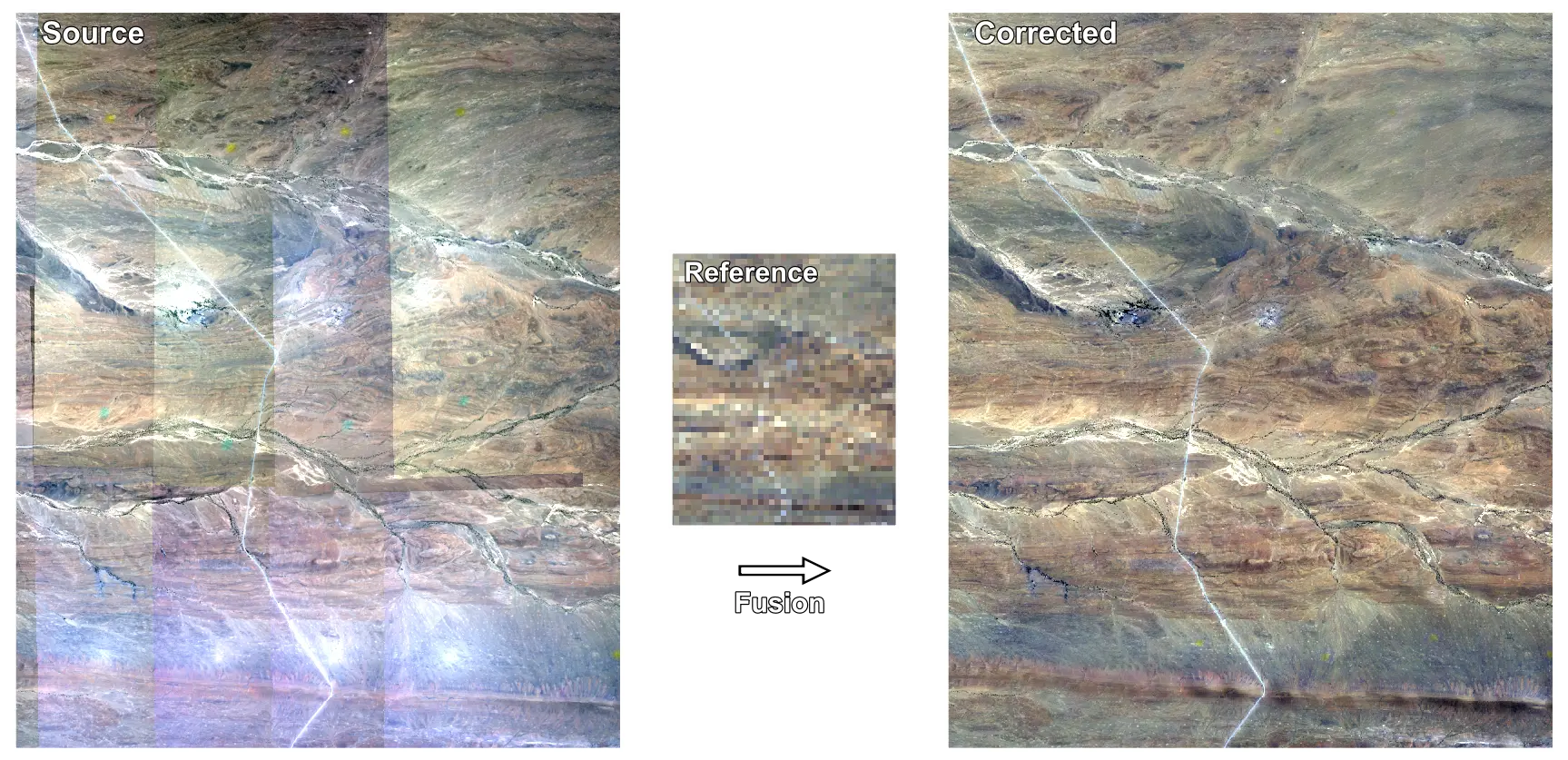Background
Reference image

homonim fuses a source image with a reference surface reflectance image to produce the corrected image. The reference must be supplied by the user, and is usually a satellite image at a coarser resolution that the source. For best results, the reference should satisfy these criteria:
Co-location: bounds of the reference image should cover those of the source, and source and reference should be ortho-rectified / co-registered.
Concurrency: source and reference capture dates should be close in time, with minimal land cover change between them.
Spectral similarity: the reference should contain bands whose spectral responses overlap with those of the source.
Satellite programs, such as Landsat, Sentinel-2, and MODIS, provide suitable reference imagery freely to the public. geedim is recommended as a companion tool to homonim for acquiring cloud/shadow-free reference imagery from these, and other programs. geedim acquired imagery includes metadata that is used by homonim for automatic spectral band matching. Alternatively, satellite imagery is available from a number of sources including the Google, Amazon and Microsoft repositories.
Note
The regression modelling and drone correction tutorials include sections showing the use of geedim for downloading reference imagery.
Source image
Any orthorectified, multi-spectral source imagery can be used with homonim, including drone, aerial and satellite imagery. Source images should preferably be provided to homonim without gamma correction or colour balancing type adjustments. If this is not possible, homonim should still improve surface reflectance accuracy.
Fusion
homonim uses spatially varying localised models to describe the surface reflectance relationship between source and reference. These models are fitted at each pixel location, inside a small kernel (window), using a fast DFT approach. After fitting, homonim produces the corrected image by applying the models to the source (i.e. “fusing” the source with the reference). From the user perspective, the model and kernel shape are the main parameters for configuring fusion.
Model
The following linear model variants are available for correcting to surface reflectance.
gain : Gain-only model, suitable for haze-free and zero offset images (i.e. images where a surface reflectance of zero corresponds to a pixel value of ± zero).
gain-blk-offset: Gain-only model applied to offset normalised image blocks. Suitable for most source-reference combinations.
gain-offset: Gain and offset model. The most accurate model, but sensitive to differences between source and reference, such as shadowing and land cover changes. Suitable for well-matched source / reference image pairs.
The derivation of the linear model approximation is given in the paper. Broadly speaking, gain compensates for atmospheric absorption and anisotropic (BRDF) effects, and offset (when present) compensates for atmospheric reflectance and haze. Offset-compensated effects tend to vary gradually and over large spatial scales, while gain-compensated effects vary over smaller spatial scales, especially for low altitude imagery, and where land cover is heterogeneous. The gain-blk-offset option models this behaviour with kernel-scale gain, and block-scale offset. It can be seen as a compromise between the gain and gain-offset options.
The model type can be specified with the --model option via the command line; or with the corresponding arguments in the homonim.RasterFuse.process() API.
Kernel shape
The kernel shape is the (height, width) of the kernel in pixels of the proc_crs image. In the default situation, where proc_crs = auto, kernel shape will be in pixels of the lowest resolution of the source and reference images.
The scale of variation that correction can adjust for is roughly the size of the kernel. Larger kernels are less susceptible to over-fitting on noisy data, but provide lower resolution correction.
The minimum kernel shape is model dependent. For the two parameter gain_offset model, the kernel should contain at least two pixels. It can contain only one pixel for the single parameter gain and gain_blk_offset models. The default value of (5, 5) will work reasonably well with the gain_blk_offset model and most source - reference image combinations. Kernels larger than (5, 5) are recommended for the gain_offset model, to avoid over-fitting.
Kernel shape can be specified with the --kernel-shape option via the command line; or with the corresponding argument in the homonim.RasterFuse.process() API.